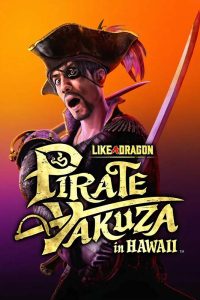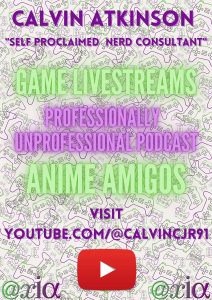Like a Dragon: Pirate Yakuza in Hawaii
If you ask a Like a Dragon fan to name their top 3 favourite characters, there is a very likely chance that Goro Majima would be in there. The Mad Dog of Shimano is a very beloved character of the series, being a source of comedy in quite serious stories, but still having a threatening aura to him, proven even more in his fighting style. He was voted as the most popular character in the franchise in a poll in 2018 and is considered a great rival to “Kiryu-Chan” due to their contrasting personalities. So, it may surprise you to hear that Majima has rarely ever had his chance as the main character, the only time he really has is in Yakuza 0 where he shared the spotlight with Kiryu, and in a bonus episode in Yakuza Kiwami 2. So, you can imagine the joy from the community when Ryu Ga Gotoku Studio (RGG Studio), during their RGG Summit in 2024, announced Like a Dragon: Pirate Yakuza in Hawaii, a side game in the Like a Dragon series with Majima as the lead protagonist. Like a Dragon: Pirate Yakuza in Hawaii was developed by RGG Studio, published by Sega and was released on 21st February 2025 for PlayStation 4 & 5, Xbox One & Series X/S and Windows.
Story
The game takes place 6 months after the events of Like a Dragon: Infinite Wealth. Goro Majima finds himself stranded on Rich Island, a small island near the shores of Hawaii, with no memories on how he got there… in fact, he has no memories whatsoever. Not long after awakening he is found by a boy named Noah Rich and his pet cat (well actually it’s a tiger but Noah insists that it’s just a cat) Goro, who Majima takes a liking to after the lad brings him water. He is brought to a small bar run by Noah’s father, Jason, and his sister, Moana, and helps them when they are being harassed by a band of pirates led by Captain Jack the Collector. Upon confronting and defeating the pirate captain, Majima is appointed the new captain of Jack’s ship, which he names the Goromaru. Majima is told by the ship’s cook Masaru that Jason used to be a pirate himself and hunted for the Lost Treasure of Esperanza, a treasure said to be worth a billion dollars and could contain the elixir of eternal life. With Noah wanting to explore the world outside of their tiny island, and after Majima convinces Jason (which in Like a Dragon terms means beating the crap out of) he agrees to join the Goro pirates, and they set off in search of this treasure and to make Noah’s dream a reality.
This is probably the most fun Like a Dragon story so far. It’s still filled with what you’d expect from one of these games, conspiracy, betrayal and powerful people looking to obtain more power (insert political joke here), but it also has a certain air of silliness and light-heartedness to it – honestly, having traditional pirates roaming the seas in modern day is already kind of funny. It’s great to see Majima as a lead protagonist again, it just further exemplifies how great of a character he is. He finds a way to be funny during the more serious moments without it ruining the tension and his goofiness doesn’t distract from how serious of a character he can be and feels natural for him – something that I don’t they did as well with Ichiban in the previous game, increasing his goofiness that even for him felt out of place.
Presentation
Let’s get the obvious out of the way, this is a Like a Dragon game, it uses the Dragon Engine, so obviously it looks brilliant. The moves you pull off in battle retain the flashiness of Like a Dragon Gaiden, and the environment has the mesmerising colour of Infinite Wealth. Even traversal on the open sea is enhanced by the presentation, mostly with the water physics. Watching as your ship bobs up and down because of the waves and the water itself just looking great as well.
This game continues to have the series trend of having one of the best Japanese casts I’ve ever seen. Hidenari Ugaki returns to play as Goro Majima and once again nails the character. Uika First Summer – who played Akame in Like a Dragon Gaiden – also makes a comeback, this time playing as Noah Rich, and she continues to be a standout in this game. One big difference between Infinite Wealth and Pirate Yakuza in Hawaii is the lack of English dialogue in the Japanese dub, this time having everyone just speak Japanese, even when Majima isn’t in the room. There is a bit of English, but it’s either spoken in the overworld when a gang approaches you for a fight, which I imagine was brought over from Infinite Wealth, or during minigames, which I suspect was either an oversight or due to them not recording any Japanese lines. It’s not a complaint, this is a smaller game than Infinite Wealth, so they probably weren’t able to throw in English dialogue, plus Majima did acknowledge the language barrier in the beginning of the game so it’s forgivable.
The music in this game is really great. A large portion of the soundtrack is what you’d expect from a Like a Dragon game, intense techno tracks that would feel at home in a Devil May Cry game if the genre changed. Though there are a few tracks that try to capture the feel of being a pirate on the open seas, and goddamn they nail it. Using more string instruments than the other battle themes and being a combination of light-hearted and intense. Both sounds fit the game super well, I can’t pick a favourite, a genuinely epic soundtrack.
World Design
There are a few locations you will go back and forth from, but there are two key locations you’ll be returning to consistently. The first being Honolulu, which is essentially unchanged from your time in Infinite Wealth. There are a few differences, such as different minigames and a noticeable lack of weapons shops (now being replaced with clothing stores), but everything else is practically identical to your last visit.
The second location is Madlantis, a pirate’s haven where the scourge of the sea congregate and battle each other. This is a lot smaller than Honolulu, though there are your usual attractions, shops, eateries and a few minigames. You won’t be spending as much time here as you will in Honolulu, so the smaller size isn’t a complaint, plus it just means it’s more tightly packed, so getting from one section to another won’t take nearly as long. There is one key reason that this place exists, but we’ll get to that later.
Of course, it being a pirate game, your main method of transportation is via ship. There are a number of sea maps, each of which connects to one of the traversable locations. Each map is filled with smaller islands, with spots that you can get off at and hunt for treasure and fight enemies (though I’m getting ahead of myself here). Also spread across these maps are lighthouses, where you can check up on your crew, swap out your crew formation and warp to other lighthouses and maps, which is something that I don’t really like. It’s not the fact that I can do all this stuff at lighthouses, it’s the fact that I can only do this stuff at lighthouses. Now, not being able to swap out my crew formations or change anything about my ship is annoying but manageable, it’s an inconvenience but I can live with it, what is annoying though is not just being able to warp to a lighthouse from anywhere on the map. Traversal by sea can be quite sluggish, there are hoops you can run through to make you go faster, but there’s only so much that that can help, especially as some of the visitable islands can be quite a trek from the closest lighthouse. It would have been more convenient to just let me instantly fast travel to the lighthouses from anywhere, thus making these sections a bit less of a slog.
On Land Combat
This game returns to the old beat ‘em up formula that worked so well with the series before it got infiltrated by turn-based mechanics. Like with Like a Dragon Gaiden you have access to two separate styles of combat. The first is the Mad Dog Style, which is reminiscent of his Thug style from Yakuza 0, though this time Majima’s not afraid to cut people up with his knife. This style utilises Majima’s fists and his knife, focusing on quick and vicious combos, without a doubt best used for smaller skirmishes. With this style you also get a special attack called Doppelgangers, an ability likely brought over from his boss fight in Yakuza: Like a Dragon, where Majima clones himself, and these clones will absolutely decimate your opponents, spreading out the carnage against multiple attackers or ganging up on a single enemy completely annihilating them in record time. This style is Majima through and through, fairly basic yet fast combos with brutal finishers, it’s easy to get the hang of but it doesn’t take away how fun it is.
The second style you have is the Sea Dog Style. This is where Majima fully embraces his pirate persona, complete with full costume and dual cutlasses. This style focuses a lot on slower but wider attacks that could possibly hit multiple targets at once, so this is the one you’ll most likely use in bigger battles. This is the style that you’ll be unlocking the most in, the Mad Dog Style already has everything you need, you just have to buy the extra skills, Sea Dog on the other hand has more that you can obtain and utilise. On top of your swords, you also have access to a gun, which has to be charged up but can destroy enemies from a distance, and a hook and chain, which will bring you closer towards opponents and can even be used while exploring to help you find extra goodies. On top of those you get access to the Dark Instruments, these instruments are powerful artifacts that if played will deal devastating AoE attacks that will do a number of enemy forces. This is a style that definitely gets better with time, and eventually I found myself favouring it over the Mad Dog Style. While that one was good, I felt that this one had more variety and overall found it more fun to use. I still used the Mad Dog Style all the way into the endgame, but I still used this one more.
Of course, it’s not a beat ‘em up style Like a Dragon game without the Heat Actions. If the Heat Gauge is full and you’re in the right conditions or just pull off the right attack, you can trigger an attack that will deal heavy damage to a single or multiple opponents at once. It’s a staple of the series and it’s still incredibly satisfying to pull off.
There are multiple battles in which you won’t be going in alone. Your crewmates, sometimes a couple of the main side characters, sometimes a large portion of the Goro Pirates, will enter the fray with you and fight especially large groups of enemies alongside you. You would hope that these allies would be useful and not make you do the majority of the work, well thankfully they are… depending on their stats. Yep, your crewmates need to be levelled up to become more powerful, building up their attack and defence stats to have a fighting chance in more dangerous battles. Some specific characters will even perform a Heat Action with you, dealing heavy damage to multiple enemies at once. Finally, in these battles you have access to support skills, these are temporary power-ups to aid you in these larger battles and despite their simplicity – they’ll often be things like increase defence or will gradually heal your party – they can completely turn a losing fight into a victory. These skills do have to be charged up though, and your opponents also have access to their own support skills, so you best be careful.
Ship Combat
Again, this is a pirate game, so there’s bound to be a decent number of ship-on-ship battles. Your main weapons are two machine guns, which are fired straight ahead, and cannons on both the left and the right of your ship. Machine guns can’t fire continuously and will need a couple of seconds to cool down, but it really doesn’t take long for them to be ready to fire again. The cannons on the other hand will need to charge up after a shot before you can fire again, how long it takes will depend on the cannon you’re using.
You also have the ability to boost your ship forward, either to crash into an enemy ship or avoid a barrage of cannon balls. The boost will have to be charged once used, though you can hold down the button to forcibly blast yourself forward before it’s fully charged, though you can only do that a limited number of times.
It’s not just attacks and boosts though; battles will also require a decent amount of ship maintenance. Such as repairing any damage dealt to the ship, with the caveat being that you can’t fire your weapons during that time. You may even have to move away from the captain’s wheel to fix a problem, such as reviving a fallen crewmate or putting out a raging fire slowly whittling down your ship’s health.
One thing I really like is how the ocean can affect combat for both you and enemy ships. This is mostly with the waves, the ships bobbing up and down and having to glide over giant waves can completely throw off the trajectory of a cannon shot, either screwing you over or saving you from damage. It adds more risk assessment and makes you consider when the best time to attack would be.
Finally, in some fights, once the enemy ship’s been stripped of health, we move onto the on-deck battle. This is where you can a select few of your crewmates raid the enemy’s deck and enter an all-out brawl with their crew and captains. These battles can get intense and it’s very easy to become overwhelmed and have a quick defeat, especially if your crew’s not at the appropriate level.
Overall, I was expecting to enjoy naval combat, but I’m still surprised by how much fun it was. Yes, it can add to the slog that is traversing the sea, but when you’re looking for it, it can be some of the most fun you can have in this game. It’s easy to dominate, but it’s also very easy to be dominated, even with the strongest equipment and the best crew, ensuring that the tougher fights still have that tension and can be dangerous if you’re not careful.
Side Quests and Minigames
Let’s start off with the obvious, substories are once again back, and they are still wild and a lot of fun. What I especially like with a number of these is how it references the events of Infinite Wealth, not only having characters mention the events of that game but also having characters with substories from that game have another this time around. Previously, substories would have rewarded you with some money or something you can use to heal, sell or hit people with, though this time the rewards are a lot better… new crewmates. Yep, a number of these substories will result in you gaining a new addition to the Goromaru, in fact, these crewmates will often be of a higher quality than others you can just find on the street, having better stats immediately and having a higher max level.
Speaking of other crewmates, yes you can often find them hanging on the streets of Honolulu or the walkways of Madlantis. They won’t join your crew just because you asked nicely though (obviously) often asking you to do something for them before you can recruit them. Sometimes something small like giving them a particular healing item or getting a certain score in a minigame, though there are others who will ask for more exotic items or will require you to be a certain pirates rank.
Now, this is a Like a Dragon game, so you know what I’m about to say, the amount of minigames available is once again ludicrous. There are your usual suspects, karaoke (the song Midnight Desire is my personal favourite, though it’s also great to see 24 Hour Cinderella back), casinos and mahjong. As well as some returning from the games staring Ichiban, like Dragon Kart and Crazy Delivery. Arcades make a return so you can still play your favourite classic Sega games, and there are even a couple of Master Systems lying about, letting you play entire games for said consoles.
Though for side content unique to this game, there are a few that you’ll find. The first is treasure hunting – I mean, it wouldn’t be a very good pirate game without it. I’ve mentioned that in each ocean map are a number of invadable islands where you can hunt for treasure. You enter these with four other crewmates of your choosing, fight and destroy either a massive group of enemies or go through a gauntlet of smaller groups to find the treasure at the end. These treasures will reward you with a large sum of money and reputation.
Next is the Pirate Colosseum, aka the main non-story reason why Madlantis exists. This is the tournament minigame you’ll find in most Like a Dragon games focused entirely on naval combat. I’ve already expressed how much fun I found naval combat, so as you would imagine I found the Pirate Colosseum a ton of fun. You fight some especially difficult opponents in this one and trying to get a fast enough time to achieve S-rank in each battle added that little extra bit of challenge for me, which only increased my enjoyment more.
And finally, we have the Devil Flags. These fiends killed off one of Jason’s friends and stole his treasure, and now his daughter is out for revenge, so now it’s up to the Goromaru to hunt down and defeat them all. The Devil Flags’ ship can be found throughout the ocean maps, and they will also have taken up residence in the islands you can invade. Defeat enough of these and reach a high enough pirate’s rank, and you’ll be able to have a boss fight against one of the Devil Flags’ commanders, which your entire crew will take part in. Defeating a Devil Flags ship/crew will reward you with some treasure, and by defeating one of the commanders you’ll receive one of the Dark Instruments for your Sea Dog Style.
Overpowering
I’ve already mentioned the sluggish sea traversal as a flaw, but I’m afraid to say that I have one more. It’s way too easy to become overpowered in this game. All the other Like a Dragon games do have you becoming stronger as you continue through them, though it’s quite difficult to become truly overpowered, mostly due to how expensive it is to unlock all the skills and upgrades. In this game on the other hand, I was swimming in cash, mostly due to all the treasure hunting that I was doing, so affording upgrades was never really an issue. Yes, you could argue that finding as much treasure as I could would probably result in me becoming very powerful really quickly, but at the same time, I didn’t find all the treasure in the game, only really going after the ones that I could sail to, and even then I managed to fully upgrade Majima and the Goromaru before the end of the fourth chapter – which I have never been able to do in any other Like a Dragon game. It took away a lot of the challenge making this, for me at least, the easiest game in the series. There was still some challenge, but not enough for me.
Conclusion
For as ridiculous as the Like a Dragon series can get at times, this game is on another level. It’s a ridiculous concept starring the franchise’s most ridiculous character, and you know what? They made it work. This game is a ton of fun, the fighting is as good as ever, the ship combat is near perfect, and you can tell the people working on this were just having fun with it. If you’re a fan of the series (and have played Infinite Wealth) then I highly recommend this game. It’s gotten me look forward to seeing what side game RGG Studio does next and has once again got me hoping for a game focused on Majima in the future.
9.2/10
Anime Amigo and Nerd Consultant
Share This Post:








Leave a Reply